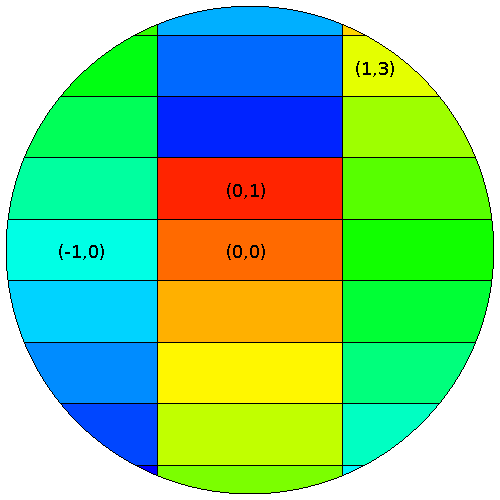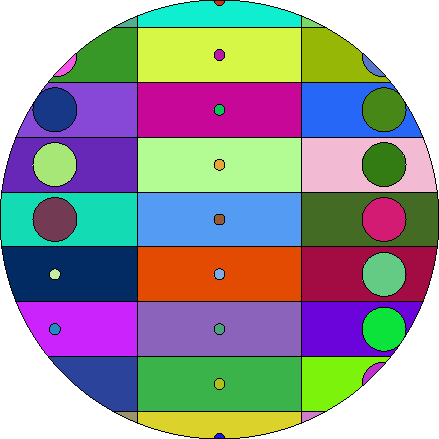This repository contains the development version of t4_geom_convert, a Python
tool to convert MCNP geometries into the TRIPOLI-4® format.
Here is a list of features of the MCNP modelling engine that are
at least partially supported and converted by t4_geom_convert:
- All surface types
- Boolean cell operators
LIKE n BUTsyntax- Affine transformations on surfaces and on cells (see the Current limitations section though)
- Boundary conditions (reflection, white surfaces)
- Isotopic compositions and cell densities
- Universes and fills, even nested, possibly with affine transformations
- Lattices
t4_geom_convert is available on PyPI. The suggested way to install it
is to use the pip/pip3 package manager and the venv
module. If pip3 and venv are not available on your machine, you can
use your package manager to install them:
# sudo apt install python3-pip python3-venv # on Debian/Ubuntu
# sudo yum install python3-pip python3-libs # on Fedora/CentOS
You can then create a virtual Python environment and install the latest stable
version of t4_geom_convert there with
$ python3 -m venv /path/to/some/folder
$ source /path/to/some/folder/bin/activate
$ pip3 install -U pip setuptools
$ pip3 install t4_geom_convert
This will install the t4_geom_convert executable in
/path/to/some/folder/bin/t4_geom_convert. Sourcing
/path/to/some/folder/bin/activate will put t4_geom_convert in your PATH.
You can also install the latest development version with
$ pip3 install git+https://github.com/arekfu/t4_geom_convert.git@next
You can find more information about pip3 and venv on the
web.
The MCNP input file is parsed by MIP. We use a slightly modified version of
MIP, which is shipped along with t4_geom_convert. MIP depends on TatSu.
t4_geom_convert also depends on NumPy.
The basic usage is simply
$ t4_geom_convert <mcnp_input>
This will create a TRIPOLI-4 output file called <mcnp_input>.t4 containing
the converted geometry. You can also choose a different name for the output
file using the -o option.
Use the -h option for a list of all available options.
t4_geom_convert is capable of handling the conversion of repeated structures
(lattices). Hexahedral lattices (LAT=1) and hexagonal (LAT=2) are
supported.
The cell declared as LAT=1 or LAT=2 represents the unit cell of the
lattice, which is assumed to repeat in all directions up to the boundaries of
the enclosing cell. Due to limitations of the TRIPOLI-4 representation of
lattices, we have chosen to represent lattices using a purely surface-based
approach. This means that t4_geom_convert will actually emit separate cell
definitions for each cell of the lattice that is visible through the enclosing
cell. The ranges of cell definitions to be emitted must be specified by the
user via the --lattice command-line option. For instance, consider the
following MCNP input:
A lattice example
1 0 -2 1 -4 3 IMP:N=1 U=2 LAT=1
10 1 -1. -10 IMP:N=1 FILL=2
1000 0 10 IMP:N=0
1 PX -1.5
2 PX 1.5
3 PY -0.5
4 PY 0.5
10 SO 4
m1 13027 1.
Here the unit cell is two-dimensional. The lattice fills a sphere of radius 4. Assuming the unit cell is indexed as (0,0), the visible lattice cells are
- (-1, -4) to (-1, 4)
- (0, -4) to (0, 4)
- (1, -4) to (1, 4)
This can be confirmed by visual inspection of the MCNP geometry or by
geometrical considerations. Once the index bounds are determined, the
--lattice option must be specified as
$ t4_geom_convert --lattice 1,-1:1,-4:4 <mcnp_input>
↑ ↑ ↑ ↑ ↑
cell number ───┘ │ │ │ └ j-range upper bound
i-range lower bound ───┘ │ └─── j-range lower bound
i-range upper bound ───┘
This results in the following TRIPOLI-4 geometry (X-Y cut), where a few cell
indices have been annotated:

The syntax for one-dimensional lattices is
--lattice <cell>,<i-from>:<i-to>
and for three-dimensional lattices it is
--lattice <cell>,<i-from>:<i-to>,<j-from>:<j-to>,<k-from>:<k-to>
Note that the ijk axes are not necessarily the same as the coordinate axes.
The orientation of the lattice axes is specified by MCNP (see the Lattice
indexing paragraph in the User's Manual) and it is determined by the order in
which the surfaces of the unit cell appear specified. In our example, the first
surface appearing in the definition of the unit cell is surface 2; therefore,
surface 2 separates the unit cell (0, 0) from cell (1, 0); the next surface
(1) separates the unit cell from cell (-1, 0); the following surfaces, 4
and 3, separate the unit cell from cells (0, 1) and (0, -1), respectively.
For hexagonal lattices, t4_geom_convert follows the convention described in
the MCNP manual. The lattice axes are defined by the first and the third plane
appearing in the definition of the base cell. The positive direction of the
third axis (if present) is defined by the normal to the seventh plane appearing
in the definition.
A lattice unit cell may appear as a fill pattern in several enclosing cells. It is currently not possible to specify different fill ranges for each of them.
MCNP provides a syntax for the specification of lattice with heterogeneous cells. An example is
A lattice example
c cells
2 0 -21 u=2 imp:n=1
21 0 21 u=2 imp:n=1
3 0 -31 u=3 imp:n=1
31 0 31 u=3 imp:n=1
10 0 -2 1 3 -4 lat=1 u=20 IMP:N=1
FILL=-1:1 -4:4
c i=-1 i=0 i=1
2 3 2 $ j=-4
2 3 2 $ j=-3
2 3 2 $ j=-2
2 3 2 $ j=-1
2 3 2 $ j=0
3 3 2 $ j=1
3 3 2 $ j=2
3 3 2 $ j=3
3 3 2 $ j=4
100 1 -1. -10 IMP:N=1 FILL=20
1000 0 10 IMP:N=0
1 PX -1.5
2 PX 1.5
3 PY -0.5
4 PY 0.5
10 SO 4
21 SO 0.4
31 SO 0.1
m1 13027 1.
The FILL=-1:1 -4:4 option indicates the range of indices where cells will be
specified. The universes filling the cells are detailed in the table below,
which by convention loops over the leftmost (i) axis first. This syntax is
supported by t4_geom_convert and does not require a --lattice option. One
restriction applies: none of the subcells may be filled with the universe of
the lattice cell itself. This syntax indicates to MCNP that the cell should be
filled with the material of the lattice cell. Using 0 as a universe number
for the subcells is supported and results in no subcell being generated.
Here is how the example above is converted and rendered in TRIPOLI-4:

Here is a list of some things that t4_geom_convert cannot currently do, but
may be able to do in the future (in roughly decreasing order of likelihood):
- Import the title of the MCNP input file (tracked in issue #5)
- Handle affine transformations with
m=-1(the last parameter of the affine transformation) (tracked in issue #12) - Optimize fills with negative universes (do not intersect with the enclosing cell) (tracked in issue #13)
- Warn about isotopes that are missing from the TRIPOLI-4 dictionary (currently you need to edit the converted file by hand and remove the occurrences of the missing isotopes)
- Convert cell temperatures
- Import comments describing the MCNP cells/surfaces (tracked in issue #9)
- Provide a way to specify lattice fill ranges per enclosing cell(s) (this needs to be specified in such a way that it works with nested lattices, too)
- Deduplicate repeated cell definitions (this is a bit harder than deduplicating surfaces)
- Produce a TRIPOLI-4 connectivity map for as many cells as possible (mostly lattices)
- Recognize and automatically suppress empty cells (they may be generated
by lattice development or fill development)
- Use a linear programming solver for cells bounded by planes?
- Use a SAT solver in the general case?
- Convert (some) MCNP source definitions
- Convert (some) MCNP tally definitions
Your help is welcome! Feel free to open an issue if you would like to implement a new feature or contribute to the project in any way.
The full changelog is here.
The correctness of t4_geom_convert is tested using a specific test
oracle, which is included in this repository.
Please report any bug/feature request on the GitHub issues page.
The development of t4_geom_convert was partially financed by the EUROfusion
consortium. t4_geom_convert is released under the terms of the GNU General
Public Licence, version 3.